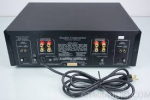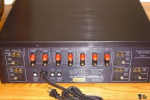Good design practice dictates that you choose an amp with at least 10% more power than you need. But under no circumstances should you exceed the rated power output.
Happens all the time. You'll also find regular 8 ohm speakers hung on 70 volt lines which will really drop the impedance. Probably won't cut out since amps are pretty well protected but you won't get the volume you expect.
A non-recommended way to find those illegal speakers without transformers is to disconnect the wiring from the amp and apply 120 volts. Those 8 ohm speaker voice coils will vaporize.
-Hal
On large installations, only the speaker without transformer will produce much sound. The low impedance will consume almost all available power.
I was called to help with a school that the custodian/handyman was having trouble with such a system.
I asked what was going on and he told me that he added a new speaker and it was the only one working. Once he realized that the only one that worked had no transformer, he rewired all the others to bypass the transformer.








